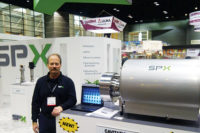Engineering R&D: Out of the lab, into the plant

In 1999, the researchers—Heather M. Hudson, now a research scientist at Kraft Foods Inc.; and two faculty members of NC State’s Department of Food Science, Christopher R. Daubert and chemist E. Allen Foegeding—filed a patent application for a process to hydrolyze a protein preparation, then gel it, dry it and granulate it to produce a stable food ingredient.
Two years later, patent No. 6,261,624 was issued. In the meantime, the researchers continued work to adapt processes they used in the lab to conditions in a whey drying plant. Freeze-drying would not be practical in a commercial application, and in December 2001 the researchers announced the process had been successfully modified to accommodate spray drying, instead.
Recognizing the commercial potential for such an ingredient, entrepreneurs licensed the technology from NC State and began a dialogue with the dozen or so North America producers of whey protein concentrate who could realistically apply it. Borrowing the surname initials of the three inventors, they named their Greensboro, N.C.-based firm HDF Technologies.
Pilot plant tests with 80 percent whey protein concentrate at Grande Cheese Co. in Lomira, Wis., were very encouraging, and promoters of the technology are optimistic commercial scale-up will occur next year. Food Engineering recently spoke with Daubert about the technology’s development and some of the remaining hurdles. A native of Fredericksburg, Pa., Daubert worked as a co-op engineer at Hershey Foods while attending Penn State University, where he earned a Bachelor of Science degree in agricultural engineering. Daubert was awarded PhDs in agricultural engineering and food science in 1996 from Michigan State University.

Daubert: We were working with the Durham (N.C.) VA Medical Center to try to help people with swallowing disorders. The muscles that control bolus (food mass in the mouth) manipulation often are damaged in stroke victims and other patients. Swallowing requires precise muscular control to keep the bolus together, and stroke victims are at risk of aspirating the bolus, which can lead to pneumonia and other complications. Traditionally, these patients are given food with starch-based thickeners to help them strengthen those muscles and swallow safely.
Our department has a long history of success in working with dairy protein. Heather Hudson, who was my grad student at the time, and I thought it would be great to give those patients a protein that would function like starch, thereby addressing both their therapeutic and nutritional needs. If patients can’t swallow a healthy diet, they can’t overcome their health problems. Proteins are the building blocks of recuperation.
FE: What had to be done to the whey protein to use it as a thickening agent?
Daubert: We patterned the process after a pregelatinization operation for starches. Initially we solubilized the protein in water, heated it to a gel, then dried it in a freeze dryer and ground it into a powder. When we re-emersed the resulting powder in a liquid, it did not thicken. We reasoned that modifying the protein by lowering the pH before gelatinization would overcome the problem. We optimized the process to give us the best pH condition, which was below 4, from an initial acidity of about 6.8. With this additional step, we were able to create a powder that instantly thickened when re-introduced to water. The details are described in Heather’s dissertation and in our published research. She supplied a lot of the brainpower.
FE: Have you executed the process using proteins other than whey?
Daubert: We have considered it but so far have not applied it to other protein sources. There is no reason to believe it wouldn’t work. But our intent is to help dairy farmers add value to their milk, and one way of accomplishing that is by building a market for the whey that is a byproduct of cheese production. This process creates an ingredient that is all natural and very nutritious.
FE: Ice cream formulators are excited about whey protein’s potential. Would you anticipate that being the first commercial application?
Daubert: It’s a possibility, but the fact that the ingredient has a low pH is an issue with ice cream. I would probably try it first in a sherbet or a fruity frozen dessert. Yogurt is another possibility, as are healthy shakes and other beverages. Cooked products also are a potential application.
In the lab, we worked with the protein as a powder, but if you go back one step, you might have a superior ingredient. How much protein should we start with? What are the best possible starting materials, in terms of the quality of the protein, how it is prepared and other factors? A lot of optimization remains to be done, but a low-pH protein thickening agent has great potential and amazing water holding and lipid-holding capabilities.
Spray dryers like these units at Cabot Creamery’s Middlebury, Vt., plant could be used to convert whey protein into a thickening agent that enhances the nutritional value of food. FE: Can thermally- and pH-stable protein compete with starch as a commercial thickening agent? Daubert: Starch production is massive, and producers do a great job. It’s an amazing ingredient, and it’s so cheap. A protein thickening agent will be a bit more expensive, but one of the benefits is that it would enable processors to adhere to an all-dairy ingredient label. Alternatively, it could be used in combination with starch to add additional functionality and nutrition to a food.
FE: It seems logical to execute this process at a cheese plant that already is converting whey into whey protein concentrate.
Daubert: Yes, you could set up this process next to a cheese plant. Freeze drying isn’t practical on a commercial scale, so a question that came up early in development was the feasibility of spray drying. We modified the process and found that, yes, you could spray dry it, though you have to gel it slightly before you get to that stage. We have a very small spray dryer in our lab, but it isn’t commercially scaleable. HDF Technologies now is working with a cheese maker to develop a scaled-up process.
FE: Might the capital investment to execute this process be prohibitive, even in a whey protein concentrate operation?
Daubert: It’s a very simple modification in that case. Essentially one additional step is being added to lower the pH, then heat it and put it in the dryer. There is a lot of optimization left to be done, and we’re continuing to explore ways to produce this ingredient more cost effectively.
FE: Any predictions on when the first commercially viable production might commence?
Daubert: It depends on the success of HDF. The CEO, Larry Sharp, has a lot of energy and enthusiasm. If he can demonstrate there is a market for this and that it can be produced cost effectively, we could see an application in the not-too-distant future.
Looking for a reprint of this article?
From high-res PDFs to custom plaques, order your copy today!






